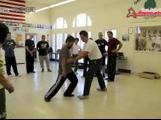 |
Introduced in a brief video clip (2002) as a preview of his DVD collection by Master Chen, these rules are translated from Master Hong’s written work in his book. |
| 1. The body can only behave in two ways: a positive circle or negative circle. There are no other movements involved. Learning and practicing of the Yilu routine is the process of getting onto these two circles and elimination of the non-circular movements.
2. The physical powering up must conform to the 10 word maxim of : pushing out with the hand and withdraw with the elbow. These are the actual movements of the two circles. 3. The left hand cannot travel to the right side of the body while the right hand cannot travel to the left side of the body. |
 |
 |
4. The upper body must be separated from the lower body and then connected in opposite ways. They cannot be synchronized. The synchronization of the upper and lower body is the cause of double heavy.
5. The left side of the body must be separated from the right side of the body. They must then be connected in opposite directions. This will lead to Yin-Yang separation. Yin-Yang separation is the solution to double heaviness. 6. The hands must at all times spin outward from the center of the body while the elbow must at all times spin inwards towards the center of the body. |
| 7. The hand can only travel within the area of the eyebrow and Dantian.
8. The body must be centered. This means the torso must be perpendicular to the ground. The spine must be straight so there is no stress on it. It must be relaxed and light. Think of the line between the two points of Baihui and Huiyin as the spin. 9. In a positive circle, the hand is always higher than the elbow. The shoulders should also be higher than the elbow at all times. The elbow is always lower than the shoulder and the hand. The shoulder should always be pulled downwards towards the kua. 10. In the Negative circle, the hand can be lower than the elbow at the end of the second half of the circle. 11. When applying any technique in Pushhands, the point-of-contact must be fixed and can never move. |
 |
12. Upper body and hands can only be used for adjustments.
13. Movement and power can only come from the feet.
14. The waist is where the power of the body is transferred to various places. It’s does not move or toss.
15. The Kua must be open
16. The knees can only move up and down
17. The “Dong” must be tight and round.
18. Tailbone must pull down and hook back to form a triangle with the two feet.
This can be compared to the Practical Method Rules List 2012 (translated), Practical Method Characteristics 2008


